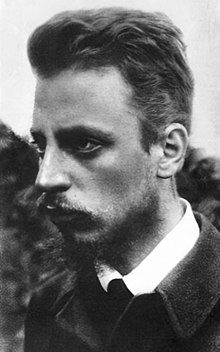
Back Rainer Maria Rilke Afrikaans Rainer Maria Rilke ALS راينر ماريا ريلكه Arabic راينر ماريا ريلكه ARZ Rainer Maria Rilke AST Rayner Mariya Rilke Azerbaijani راینر ماریا ریلکه AZB Райнер Мария Рильке Bashkir Райнер Марыя Рыльке Byelorussian Райнэр Марыя Рыльке BE-X-OLD
Rainer Maria Rilke | |
|---|---|
 Rilke in 1900 | |
| Born | René Karl Wilhelm Johann Josef Maria Rilke 4 December 1875 Prague, Bohemia, Austria-Hungary |
| Died | 29 December 1926 (aged 51) Montreux, Vaud, Switzerland |
| Occupation | Poet, novelist |
| Language | German, French |
| Nationality | Austrian |
| Period | 1894–1925 |
| Literary movement | Modernism |
| Spouse | |
| Children | 1 |
| Signature | |
René Karl Wilhelm Johann Josef Maria Rilke (4 December 1875 – 29 December 1926), known as Rainer Maria Rilke (German: [ˈʁaɪnɐ maˈʁiːa ˈʁɪlkə]), was an Austrian poet and novelist. Acclaimed as an idiosyncratic and expressive poet, he is widely recognized as a significant writer in the German language.[1] His work is viewed by critics and scholars as possessing undertones of mysticism, exploring themes of subjective experience and disbelief.[2][3][4] His writings include one novel, several collections of poetry and several volumes of correspondence.
Rilke traveled extensively throughout Europe, finally settling in Switzerland, which provided the inspiration for many of his poems. While Rilke is best known for his contributions to German literature, he also wrote in French. Among English-language readers, his best-known works include two poetry collections: Duino Elegies (Duineser Elegien) and Sonnets to Orpheus (Die Sonette an Orpheus), a semi-autobiographical novel The Notebooks of Malte Laurids Brigge (Die Aufzeichnungen des Malte Laurids Brigge), and a collection of ten letters published posthumously Letters to a Young Poet (Briefe an einen jungen Dichter). In the later 20th century, his work found new audiences in citations by self-help authors[5][6][7] and frequent quotations in television shows, books and motion pictures.[8]
- ^ Biography: Rainer Maria Rilke 1875–1926, Poetry Foundation website. Retrieved 2 February 2013.
- ^ Müller, Hans Rudolf. Rainer Maria Rilke als Mystiker: Bekenntnis und Lebensdeutung in Rilkes Dichtungen (Berlin: Furche 1935)
- ^ Stanley, Patricia H. "Rilke's Duino Elegies: An Alternative Approach to the Study of Mysticism" in Heep, Hartmut (editor). Unreading Rilke: Unorthodox Approaches to a Cultural Myth (New York: Peter Lang 2000).
- ^ Freedman 1998, p. 515.
- ^ Komar, Kathleen L. "Rilke: Metaphysics in a New Age" in Bauschinger, Sigrid and Cocalis, Susan. Rilke-Rezeptionen: Rilke Reconsidered (Tübingen/Basel: Franke, 1995), pp. 155–169. Rilke reinterpreted "as a master who can lead us to a more fulfilled and less anxious life".
- ^ Komar, Kathleen L. "Rethinking Rilke's Duisiner Elegien at the End of the Millennium" in Metzger, Erika A. A Companion to the Works of Rainer Maria Rilke (Rochester, New York: Camden House, 2004), pp. 188–189.
- ^ See also: Mood, John. Rilke on Love and Other Difficulties (New York: W. W. Norton & Company, 1975); and a book released by Rilke’s own publisher Insel Verlag, Hauschild, Vera (ed.), Rilke für Gestreßte (Frankfurt am Main: Insel-Verlag, 1998).
- ^ Komar, Kathleen L. "Rethinking Rilke's Duisiner Elegien at the End of the Millennium" in Metzger, Erika A., A Companion to the Works of Rainer Maria Rilke (Rochester, New York: Camden House, 2004), 189.
© MMXXIII Rich X Search. We shall prevail. All rights reserved. Rich X Search